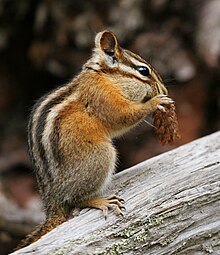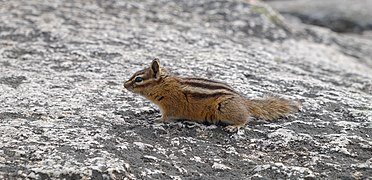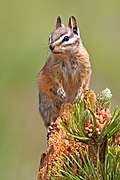Least chipmunk
| Least chipmunk | |
|---|---|

| |
| Scientific classification | |
| Domain: | Eukaryota |
| Kingdom: | Animalia |
| Phylum: | Chordata |
| Class: | Mammalia |
| Order: | Rodentia |
| Family: | Sciuridae |
| Genus: | Neotamias |
| Species: | N. minimus
|
| Binomial name | |
| Neotamias minimus (Bachman, 1839)
| |

| |
| Distribution of the least chipmunk | |
| Synonyms | |
| |
The least chipmunk (Neotamias minimus) is the smallest species of chipmunk[2] and the most widespread in North America.
Description
It is the smallest species of chipmunk, measuring about 15.7–25 cm (6.2–9.8 in) in total length with a weight of 25–66 g (0.88–2.33 oz).[3] The body is gray to reddish-brown on the sides, and grayish white on the underparts. The back is marked with five dark brown to black stripes separated by four white or cream-colored stripes, all of which run from the nape of the neck to the base of the tail. Two light and two dark stripes mark the face, running from the tip of the nose to the ears. The bushy tail is orange-brown in color, and measures 10–11 cm (3.9–4.3 in) long.[4] In some areas, where range overlap with the yellow-pine chipmunk occurs, it may be difficult or impossible to distinguish the two species in the field; laboratory examination of skeletal structures may be required.[5]
As in other chipmunks, there are four toes on each of the forefeet and five on the hindfeet. Females have eight
Distribution and habitat
Least chipmunks are found through most of the western United States from northern
Behavior
Least chipmunks are diurnal and eat seeds, berries, nuts, fruits and insects. They mark areas depleted of suitable food with urine, and do not return to such patches afterwards.[8] Home ranges vary widely, and have been reported to vary from 0.1 ha (0.25 acres) in northern Michigan[4] to as much as 5.5 ha (14 acres) in Colorado.[9] Because of their small size, least chipmunks are generally subordinate to yellow-pine chipmunks, which are able to drive them away from food resources where food is plentiful. However, because they need to eat less food in order to survive, least chipmunks are more numerous where resources are scarce.[10] They are agile animals, and have been recorded running at speeds of up to 7.7 km/h (4.8 mph) in natural conditions.[11]
Predators include
Least chipmunks spend the winter in burrows and also scatter-hoard food in numerous concealed pits beneath logs and similar cover. Burrows consist of a single chamber about 15 cm (5.9 in) across and tunnels 7.5 cm (3.0 in) in diameter, averaging 1.7 m (5 ft 7 in) in length. They have two to four entrances, often concealed by nearby rocks, and are typically about 18 cm (7.1 in) below the surface.[4] During the summer they may construct temporary nests in trees from leaves and grass,[12] or appropriate hollows made by woodpeckers.[4]
Least chipmunks do not hibernate, or put on excess fat in the fall. Instead, they survive the winter by entering torpor for long stretches of time, waking to eat food cached in the burrow. How much of each winter they spend below ground in this manner depends on the latitude, varying from late November to mid March in Michigan to mid October to late April in northern Manitoba.[4]
Reproduction
Females enter
Gallery
-
Neotamias minimus (side)
-
Neotamias minimus (front)
-
Least chipmunk
References
- ^ . Retrieved 19 February 2022.
- ISBN 0-395-91098-6.
- ^ Least chipmunk (Tamias minimus) Archived 2013-10-15 at the Wayback Machine, Arkive
- ^ S2CID 36836203. Archived from the original(PDF) on 2015-06-06.
- ISBN 978-1-4426-4483-0.
- JSTOR 1381291.
- OCLC 60669537.
- S2CID 33186159.
- JSTOR 1381774.
- JSTOR 1934591.
- JSTOR 1382327.
- JSTOR 1379551.




